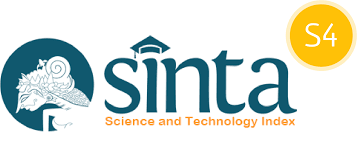EFL UNIVERSITY STUDENTS EMPLOYED A CRITERIA OF HEDGES DURING THEIR SPEAKING CLASS WITHIN THE ACADEMIC SETTING
DOI:
https://doi.org/10.52208/klasikal.v4i3.309Keywords:
Types of Hedges, EFL speaking classAbstract
Communication becomes an essential aspect in language classroom because it bridges the meaning of a person’s ideas. Therefore, as foreign language learners, the students have to have a good understanding at how to interact effectively with other students. Regarding to this, the researcher considered it is crucial to investigate English Foreign Language (EFL) university students’ ways in communication during their speaking class which includes hedges. The objectives of the research was to find out the types of hedges employed by EFL university students during their speaking class within the academic setting. This study was conducted at Politeknik LP3I Makassar and it was focused on the students in the first semesters in subject Basic Speaking with the total participants were 23 students of one class. The method used was descriptive qualitative method. There were 3 recordings based on the students’ interactions in the classroom. The theory from Riekkinen and Svarova (2009) was used to analyze the data gain. After transcribing and analyzing the data, the results showed that the students in EFL speaking class utilized some types of hedges. The hedges used involves personal evaluation, expression of limitation, expression of hesitation, and the combine hedges. Besides, the students employ hedges for some reasons.
References
Ahmed, W.K & Maros, M. (2017). Using Hedges as Relational Work by Arab EFL Students in Student-Supervisor Conslutations. GEMA Online Journal of English Studies, 17(1)
Aceron, R. M. (2015). Conversational Analysis : The Judge and Lawyers ’ Courtroom Interactions. Asia Pacific Journal of Multidisciplinary Research, 3(5), 120–127.
Bithiah, S & Tan, H. (2015). Hedges Used by ESL Students in Single-Sex and Mixed- Sex Informal Conversation. 2(2), 169-182.
Brown, P., & Levinson, S. (1987) Politeness: Some Universals in Language usage.
Cambridge: Cambridge University Press.
Coates, J. (1987). Epistemic modality and spoken discourse.Transactions of the Philological society, 85(1), 110-131.
Cowie, N. (2009). Observation. In R. A. Crocker & J. Heigham (Eds.), Qualitative research in applied linguistics: A practical introduction. London: Palgrave Macmillan.
Dousti, M & Rasekh, A.E. (2016). ELT Students’ Gender Differences in the Use of Hedges in Interpersonal Interactions: A Mixed Method Approach Applied. Journal of Applied Linguistics and Language Research. 3, 217 – 231
Fraser, B (2010) Pragmatic Competence: The Case of Hedging. In Kaltenbock, G. et al (eds.). New Approaches to Hedging, 15-34. Emerald Group Publishing Limited.
Fraser, B. (1975) "Hedged Performatives". In P. Cole and J. Morgan (eds.) Syntax and Semantics New York: Academic Press. pp.187-210.
Gay, L.R, Mills, Geoffrey E., Airasian, Peter. (2006). Educational Research Competencies for Analysis and Application (8th edition). New Jersey: Pearson Prentice Hall.
Gribanova, T. I., & Gaidukova, T. M. (2019). Hedging in different types of discourse. Training, Language and Culture, 3(2), 85-99. doi: 10.29366/2019tlc.3.2.6
Holmes J (2001). An introduction to Sociolinguistics, 2nd edition (Longman) Harlow, Communication 10(3) 185-205.
Holmes, J. (1995) Women, Men and Politeness. New York: Routledge, Tylor & Francis.
Holmes, J. (1984). Hedging your bets and sitting on the fence: Some evidence for hedges as support structures. Te Reo, 27(1), 47-62.
House J and Kasper G (1981). Politeness markers in English and German. In: conversational Routine, edited by Coulmas F The Hague (Mouton) 157- 185.
Hua. (2011). A Study of Pragmatic Functions of Hedges Applied by College English Teachers in the Class. Journal of M & D Forum from Foreign Studies Polytechnic University, China. 562-566.
Hyland,K.(1998)Hedging in scientific research articles. Amsterdam: John Benjamins.
Lakoff, George (1972). Hedges: A Study in Meaning Criteria and the Logic of Fuzzy Concept. Chicago Linguistics Society. 183-228.
Lavinson, P. (1987). Politeness: Some Universals in Language Usage. Cambridge University Press.
Miles, M.B & Huberman, A.M. (2004). Qualitative Data Analysis: An Expanded Sourcebook. Sage.
Mirzapour, F. (2016). Gender Differences in the Use of Hedges and First Person Pronouns in Research Articles of Applied Linguistics and Chemistry. International Journal of Applied Linguistics & English Literature. 6, 5, 166-173.
Nozawa, Y. (2015). The Use of Hedges in Polite Disagreement by Japanese Advanced Learners of English. 22, 2, 175-188.
Nugroho, A. (2014). Hedging in News Stories and Editorial in Jakarta Posts and The Washington Times. Journal of English Language and Culture, 4(1).
Olsson L (2000). A study of gender-related differences in introductory letters.Unpublished Master‟s Thesis, Lulea Tekniska Universitet. (Online), from http://epubl.luth.se/1402-1773/2000/62/LTU-CUPP-0062- SE.pdf.
Richard, K. (2009). Interviews. In R. A. Crocker & J. Heigham (Eds.), Qualitative research in applied lingustic: A practical introduction. London: Palgrave Macmillan.
Riekkinen, N & Svarova (2009). Softening Criticism: The Use of Lexical Hedges in Academic Spoken Interaction. University of Helsinki.
Salager-Meyer, F. (1997) "Hedges and Textual Communicative Function in Medical English Written Discourse”. English for Specific Purposes. 13. p. 149-170
Teng, Y. (2015). An Analysis of Pragmatic Functions of Hedging in American Presidential Inaugural Addresses
Varma, S.B & Tan,H. (2015). Hedges Used by ESL Students in Single-Sex and Mixed-Sex Informal Conversations. Journal of Language and Communication. 2 (2), 169-182.
Warsono, A.Y. (2016). Hedges in Classroom Speeches by English Students in Graduate Program. 6 (1), 11-19.
Wilamova. (2005). The Use of Hedges in Polite Disagreement by Japanese Advanced Learners of English. 22, 2, 175-188.
Yagiz, O & Demir, C. (2014). Hedging Strategies in Academic Discourse: A Comparative Analysis of Turkish Writers and Native Writers of English. Elsevier, Procedia-Social and Behavioral Sciences. 158, 260-268.

Downloads
Published
How to Cite
Issue
Section
License
Copyright (c) 2023 Imran Trista Udin, Zulkhaeriyah Zulkhaeriyah, Fiviyanti Hasim

This work is licensed under a Creative Commons Attribution 4.0 International License.

Klasikal: Journal of Education, Language Teaching and Science is licensed under a Creative Commons Attribution 4.0 International License.



















